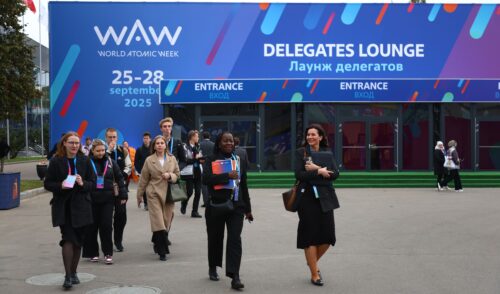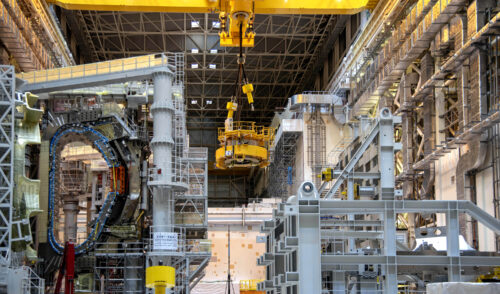
Supporting Myanmar’s Energy System
back to contentsRussia and Myanmar have signed an intergovernmental agreement on cooperation principles for constructing a small modular reactor (SMR) nuclear power plant. This is one of the key documents signed during Myanmar Prime Minister Min Aung Hlaing’s visit to Moscow. The agreement marks a crucial step toward launching the nuclear power plant project, which will alleviate power shortages in the country while improving reliability and stability of electricity supply.
Signatures secured
The agreement was signed in early March by Rosatom Director General Alexey Likhachev and Myanmar’s Union Minister of Science and Technology Myo Thein Kyaw. The document outlines the terms and areas of cooperation, focusing on building a 110 MW onshore SMR nuclear power plant with the potential to expand its capacity to 330 MW.ам
“The intergovernmental agreement on constructing a small-scale nuclear power plant paves the way for Myanmar’s economy to access affordable and sustainable energy. This will serve as a strong catalyst for further economic growth, creating thousands of jobs and developing a highly skilled workforce,” said Russian President Vladimir Putin.
This marks the second step in the project’s implementation. The first was taken in February 2023 when Russia and Myanmar signed an intergovernmental agreement on peaceful uses of nuclear energy.
Rosatom’s capabilities
Rosatom is advancing reference technologies for both offshore and onshore SMRs. In Chukotka, the floating power unit Akademik Lomonosov with KLT-40S reactors has been supplying electricity for six years. In Yakutia, the Russian nuclear corporation is preparing to pour the first concrete for an onshore SMR nuclear power plant, with a similar project under consideration in Uzbekistan. Both will use RITM-200 reactors with an electrical capacity of 55 MW. Production of these reactors has reached a commercial scale as ten of them were manufactured for five Project 22220 nuclear-powered icebreakers and another eight are in progress. Offshore SMR projects are also under development.
Beyond nuclear, Rosatom is also collaborating with Myanmar on wind energy projects.
“We are confident that SMR and wind farm projects will become jewels of bilateral cooperation.”
Iskander Azizov
Russian Ambassador to Myanmar
Myanmar’s energy needs
Myanmar’s installed power capacity totals little more than 7 GW. Half comes from fossil fuel power plants, while the other half is renewable energy, over 90% of which is hydropower. On paper, Myanmar generates 30% more electricity than it consumes. However, rising global LNG prices and payment issues forced several thermal power plants to be shut down.

As a result, available generation capacity in the country has dropped to 4.5 GW, according to the World Bank’s optimistic estimates. During the dry season, it does not exceed 3 GW, failing to meet consumer demand. Only 48% of the country’s over 50 million people have access to electricity. More than half of businesses and residents in all major cities regularly experience blackouts.
Companies and municipalities are forced to purchase diesel generators and reduce power supply hours. The Ministry of Energy has implemented a rationing schedule, dividing major cities into sectors that receive electricity in rotation. For example, households in Yangon receive eight hours of electricity per day, split into two four-hour blocks. In Mandalay, this period is even shorter, with electricity being available just six hours a day. Even these hours are not guaranteed due to frequent outages, meaning in reality, electricity is available for only two to three hours a day.
At the same time, Myanmar has the potential to become one of the next-wave ‘Asian Tigers’, but this requires sufficient foreign investment and, of course, a reliable energy foundation.
132 GWh
Myanmar’s total electricity demand
“Myanmar’s total electricity demand is estimated at around 132 GWh. The current maximum output from the country’s 29 hydropower plants, 27 gas-fired plants, two coal-fired plants, and six solar power stations totals, however, as little as 67.2 GWh, and this peak is rarely reached. In this context, Myanmar’s leadership places great hope in energy cooperation with Russia, particularly SMR and wind farm projects. These initiatives were top priorities during the March visit of the Myanmar government delegation to Russia. They will make the energy system far more reliable and diversified, forming the foundation for Myanmar’s future economic development,” noted Iskander Azizov, Russia’s Ambassador to Myanmar.
67.2 GWh
Myanmar’s current maximum electricity generation
The positive effects will be visible even during the construction phase since the energy projects will create new jobs and offer opportunities for local contractors. Once the plants are connected to the grid, business operations and daily life of households will stabilize.
The partners are committed to long-term cooperation. “Russia has consistently supported friendly nations during difficult times and will continue to assist Myanmar. We are confident that SMR and wind farm projects will become jewels of bilateral cooperation. We look forward to further productive and mutually beneficial development of the dialogue between our countries,” the ambassador concluded.
Photo by: Rosatom State Corporation, Wikipedia, Newspaper Strana Rosatom




